- Home
- William H. Keith
Symbionts Page 16
Symbionts Read online
Page 16
Dev knew; he’d been there, as had Katya and Brenda Ortiz and quite a few of the other scientists, troops, and shipjackers with Farstar. It was damned hot on the surface, uncomfortably so, but he’d needed to have one arm bare at least to accept a translator cornel; and during his final confrontation with the Naga beneath the surface of GhegnuRish, he’d actually left the environmentally controlled safety of his warstrider in order to be able to touch the alien creature directly, wearing nothing more than a shipsuit and a mask.
He was pretty sure that the data was being deliberately manipulated by the Imperial and Hegemony authorities to make communication with the DalRiss seem even more difficult and dangerous than it actually was. That was one reason why he’d insisted on such a large complement of teleoperated scouts. He wanted to enter the Alyan system with the assumption that he knew nothing, taking nothing for granted, and build up a data base independent of anything that had reached the Confederation by way of Imperial data bases, simulations, or scientists.
He was beginning to suspect that the most devastating weapon either side could wield in war was not thermonuclear warheads or kilometer-long dragonships or new and more powerful warstriders. No, the key weapon in any war was information, and Dev intended to gather as much of the precious commodity as he could before the shifting tactical situation forced him into combat.
Time passed, and the RD-40 scouts closed the dwindling gap between themselves and the alien world, fanning out from a straight-line course to make their final approach from several directions. Halfway to the target they separated into two groups, one of which continued accelerating all the way while the other flipped end over end and began coasting, ready to decelerate at the same rate. After pushing 50 Gs for over eighteen minutes, the first group was hurtling in at nearly six hundred kilometers per second, flashing through and past the Imperial squadron so quickly that only weapons directed by high-speed machines could have any chance of hitting them.
Even at that speed, however, the probes’ AI-directed sensors gathered enormous volumes of data in flickering instants of time, relaying it all back down the lasercom links to the Confederation ships. Soon, the Imperial vessels were known in enough detail to assign them names from Eagle’s warbook. The two Yari-class destroyers were the Asagiri and the Naginata; the frigates were Hayate and Reppu, both of the big, twenty-four-thousand-ton Arashi-class. The two smallest were twelve-hundred-ton Tidori-class corvettes, Sagi and Hatukari.
Rippling flashes marked missile launches from the Imperial warships. By absorbing all light and radar energies that struck their nano-camouflaged hulls, the probes were nearly invisible both optically and to radar and ladar detectors. Such invisibility was never purchased without a price, however. Energy absorbed had to be balanced by energy given off; the remote probes were fairly bright infrared targets, and the plasma trails from their drives were easily tracked when the craft were under full thrust.
The Imperial missiles were set for IR homing, and they had accelerations at least as high as those of the RD-40s, or better. And the problem was complicated now by time lag. At a range of six hundred thousand kilometers, the speed-of-light gap between the Confederation squadron and the scouts was four seconds; it took two seconds for imagery and sensory data gathered by one of the scouts to travel by comm laser back to the linked brain of the man piloting it, and two seconds more for his steering and thrust commands to return to the craft’s tiny onboard AI… by which time the high-velocity probe had moved almost twenty-four hundred kilometers.
Four seconds matters little when dealing with tens of thousands of kilometers of empty space; in close combat with enemy warships, however, four seconds becomes an eternity, a fatal eternity when fractions of a single second measure the difference between a successful maneuver and the impact of an IR-homing missile. As the RD-40s neared ShraRish, the Imperial forces in orbit began responding, sluggishly at first, then with a fast-growing firestorm of missiles and energy beams.
In rapid succession, the teleoperated probes began dying in flares of dazzling light, as IR-homing missiles slammed into their targets in direct, head-on impact, or detonated at a distance in shotgun sprays of pellets that shredded the scouts’ thin hulls and transformed them into hurtling clouds of white-hot scrap.
The battle for Alyan space had begun. So far, the exchange was bloodless, the only casualties creatures of plastic, duralloy, and electronic circuits.
But with such energies involved, and so many people, it could not remain bloodless for long.
Chapter 14
“Necessity,” runs the old proverb, “is the mother of invention.” Nowhere is this more evident than in the history of modern warfare. From the very first use of the tank in warfare, developed as a means of breaching the barriers of barbed wire, trenches, and interlocking fields of machine-gun fire on the Western Front in the First World War, to the introduction of beam and missile weaponry on orbital constructors and tugs,humans have used remarkable ingenuity both to kill and to survive.
—Juggernaut: A Brief History of Armored Combat
Chujo Aiko Hayashiya
C.E. 2525
Dev remained linked with the data simulation from the probes, listening in as Commander Duryea coordinated the far-flung network of teleoperated scout craft and operators. The voices of the linked operators formed a soft background murmur to the scene, punctuated by Duryea’s terse and number-heavy orders and demands for more data.
“Seven-two, Seven-five, Eight-one, this is Thunderhead,” Duryea’s voice said. “Divert to three-one-five at plus zero-one-one. Give us a close-up on target Tango-one-niner.”
“Roger that, Thunderhead. Seven-two breaking left and high. I’ve got Tango-one-niner locked in and on approach.”
“Nest, this is Eight-one. I copy. Locked in and on approach.”
“Probe Seven-five, Seven-five, this is Thunderhead. Do you copy?”
“Nest, Seven-five! I’ve got three India-Romeos vectoring in! Don’t know if I can dodge ’em!”
“Seven-five, Thunderhead, we copy. Maintain full Gs and pitch right to zero-five-one at plus zero-seven-three.”
“Nest, Seven-five! I can’t get clear! They’re on me! I can’t!…”
“Probe Seven-five destroyed,” the sonorous and unhurried voice of Eagle’s AI announced. Two light seconds away, one of the probes had just been smashed from the sky, while somewhere aboard one of the Confederation ships, a probe jacker, severed from his mount, was blinking awake inside a ViRcom module. Dev checked the tally list and saw that twenty-eight of the remote probes had already been lost.
But the Battle Ops rundown on the Imperial fleet was complete. In another fifteen minutes, the second group of probes, decelerating now to velocities of only a few kilometers per second, would reach ShraRish and begin mapping that world in exacting detail. The rest had either sailed past ShraRish and the Imperial squadron and were already out of the battle, or they were attempting to change their combat roles, from surveillance drones to antiship missiles.
* * *
The chances of one of the remote drones scoring a hit were slender. At the RD-40s’ incredible closing velocities, their pilots could do little more than point their steeds in the general direction of an enemy target and hope for the best. They had little in the way of lateral maneuverability, and the four-second reaction time between the moment a probe’s scanners detected something in its path and the instant its pilot’s commands reached it made fine course adjustments or complex maneuvers useless. After boosting across over half a million kilometers at 50 Gs they were low on reaction mass as well, which meant that when their containment fields collapsed, the resultant plasma detonation delivered little more than the kick of a fair-sized warhead of conventional high explosives.
Despite all of that, Probe Three-three managed to close with the Asagiri, coming in on the light destroyer nearly broadside-on. Listening to the symphony of mathematics and intercept plots singing in his brain, the jacker waited until the probe w
as some twelve hundred kilometers from the target before triggering the craft’s drive; two seconds later and six hundred thousand kilometers away, Probe Three-three flashed into plasma as hot as the core of a small sun.
The strike was, as it turned out, a near miss, the explosion flaring briefly against the blackness of space twelve kilometers short of the destroyer’s hull. Considering the distances and speeds involved, that was pinpoint accuracy indeed. The expanding plasma cloud and a clutter of molten debris slammed into Asagiri’s ventral side starboard a fraction of a second later.
Any kind of debris moving at a relative velocity of better than six hundred kilometers per second is a terrifying weapon in space. Fortunately for Asagiri, the debris cloud was expanding; much of it missed entirely, most of the surviving bits were wiped from existence by the flash of automated point defense lasers, and only a few grams of solid material actually struck home. Still, the kinetic energy of those flecks of debris was great enough that the destroyer’s hull was breached. Atmosphere spilled into space, along with some furniture and several charred bodies from her crew’s mess, but the leak was swiftly sealed off by automatics, and, in any case, the shipjackers aboard were securely enclosed within their pressurized link modules, safe from all but a direct hit on Asagiri’s heavily armored core stations. The damage was not severe enough to cripple her. A power conduit was broken, a control circuit melted, but redundant backup systems kicked in and, for the moment at least, no serious damage registered within the damage control subroutine of Asagiri’s onboard AI.
Lagging behind the faster ships of the Confederation squadron, the converted hydrogen tanker Tarazed could only manage 2 Gs, and so she maintained station with the equally slow transport Vindemiatrix, well astern of Eagle and the more powerful, more maneuverable warships.
Tarazed was constructed as five huge spheres strung together like pearls in a necklace between a tiny command module and the boxlike complexity of her fusion drive. The lead sphere had been remodeled to carry cargo and passengers; specifically, it housed the hangar decks and maintenance bays of the 1st Confederation Air/Space Wing, recently nicknamed the Bluestars.
Though acceleration dragged at him, making his lean, seventy kilos’ mass feel like a leaden one-sixty, Sublieutenant Nevin Vandis—Van to his friends—took a final walk-around, giving his warflyer a final exterior inspection. He wasn’t entirely sure what he would do if he found something that would warrant a downgrudge on the ugly little ship; he was sure he wouldn’t report it. A story popular with members of his squadron was that of Lieutenant Ben Skarbeck, an ascraft fighter pilot who, during the defense of New America, had found his number one cryo-H tank holed by a bit of shrapnel just as the alert sounded for another incoming wave of Imperial fighters. According to the story, which had already assumed mythic proportions, Skarbeck had plugged the hole with the wad of chewing gum that always seemed to be working its way around between his cheek and his gums, fueled up his ship, and launched in time to down two Imperial Ko-125 Akuma attack craft and one Se-280 interceptor.
Van chewed gum as well—it seemed to be part of the persona of front line fighterjacks when they weren’t linked to their steeds—but he wasn’t convinced that the Skarbeck story was true and didn’t really want to test the idea in combat. Most substances became uncompromisingly brittle when subjected to the temperatures and pressures required to store cryogenic slush hydrogen, and he frankly doubted that a mix of chewing gum and saliva had the chemical or physical properties of, say, the nanolayered polyduraplas sheathing the inside of his flyer’s cryo-H tanks.
Vandis was typical of the fleet’s small contingent of fighter pilots, which meant he knew he was the best of the best, the top of the link-jacked military hierarchy that ran from space fighterjacks like himself down to the mud-slogging leggers at the bottom. He’d started out five years earlier as a warstrider with the Newamie militia; his skill with finely detailed linking had qualified him as an ascraft fighter pilot, and he’d flown both I-20 Shorishahs and I-32 Sensokanazuchis for New America’s Hegemony government until the rebellion had forced him to choose between the rule of distant Earth or the more immediate and representative government of rebel New America. In point of fact, he cared little about politics one way or the other, though he was well aware that the war had already had one profound impact on his life. More than anything else he loved to fly, and since he’d been assigned to the Bluestars’ 3rd Squadron, he’d done very little else. Even during the long periods when Tarazed was isolated in K-T space, Van and his yujos in the squadron flew endlessly in simulations, jacked into their fighters and living the fantasies fed to their brains by the ship’s combat AI.
“Hey, Lieutenant!” a voice called from behind. “You really gonna wire that piece of hardware to your brain?”
Van turned, grinning. “You know a better way to get a fast jackin’jolt, Chief?” Van replied, grinning. “Anyway, she would never do anything to hurt me.”
Julio Cordova was Van’s crew chief, a short, stocky man with a heavy mustache and ebony skin who thought of the ugly little fighter as his personal property, something to be loaned out to Van with some concern about whether or not it would be returned in one piece.
“Wasn’t worried about you.” He reached up and laid a proprietary hand on the vehicle’s starboard weapons sponson. “I’m more concerned about what your impure thoughts’ll do to her once you launch.”
“Ah, you never see the parties I take her to soon as we clear the chute.” He shook his head in mock dismay. “Dancing naked on the bar… it’s shocking, Chief. You wouldn’t recognize her. How was the diagnostic?”
“Well, we had her guts out all day yesterday, Lieutenant, tryin’ to find a short in her nav system interlock.”
“You find it?”
“Nope, but the diagnostics stopped showing a downgrudge when we swapped out the EL-30 module.Could’ve been a programming glitch. Then again, maybe we bumped a loose wire back into place when we slammed the access shut.”
“Yeah, well, if I lose track of Tarazed while I’m out there, Chief,” Van said slowly, “I’ll be sure to let you know the thing’s not fixed.”
“Just so you bring her back, Lieu. Otherwise, she comes out of your pay. And your bar tab.”
“Confederation credit?”
“Gok, Lieu! That scuttin’ kuso’s not worth a nullhead’s download. Make it Hegemony yen.”
“Christ, Chief, just whose side are you on, anyway?” Van continued his walk-around beneath the hanging bulk of the ship, scanning the cryo-H tanks carefully for any ice, for any telltale wisp of vapor that might indicate a containment breach. The craft’s belly checked, he grabbed hold of a levitator strap, slipped his left boot into the stirrup, and rode up the support gantry. Careful where he placed hands and feet—a two-point-five-meter drop under two Gs killed you as dead as a five-meter fall under one—he stepped off onto the catwalk that gave access to the vehicle’s dorsal side.
At least it looked as though he wasn’t going to have to put the chewing gum idea to the test. His warflyer, an aging DR-80, was battered and chipped and scoured, with mismatched patches showing a long history of past field-expedient repairs, but its pressure hull was tight, its circuits checked out operational—with the possible exception of that glitchy nav interlock—and the RM tanks were holding pressure. Van’sGuard was ready for launch.
Warflyers were themselves the product of field expediency. Though they’d been designed originally as tugs and high-mass manipulators for construction jobs in orbit, local planetary militias had found them useful as space-maneuverable weapons platforms… a fancy term for cheap space fighters. The young Rebellion, with access to few modem air/space fighter craft, had seized on warflyers as a means of addressing the Imperium’s superiority in both technology and numbers. They were slow, they could neither operate within a planetary atmosphere nor achieve escape velocity, and many were so old that their pilots proudly claimed that stranger things than chewing gum maintained pressu
re and hull integrity.
Van’sGuard was a prime example of the type. She was a Mitsubishi DR-80, originally an orbital constructor modified for a military role under the name Tenrai, the “Heavenly Thunder.” With the new Emperor taking Tenrai as his Nengo era-name, however, Confederation pilots had taken to calling the DR-80 other things, few of them complimentary.
“Warhawk” was perhaps the most consistent name out of many, though, one without obscene or scatological implications and bearing a long tradition in the history of military aviation. A propeller-driven fighter called the Warhawk had fought with distinction in the Second World War; a nuclear-powered transatmospheric craft had been dubbed Warhawk during the Third American Civil War.
This Warhawk was an inelegant contraption, a squat cylinder three meters long stacked atop a pair of cryo-H storage tanks and a massive fusorpack and thruster. Bulky, round-ended sponsons mounted port and starboard housed weapons systems, maneuvering jets, and manipulators. The ungainly craft was, in fact, little more than a conventional warstrider with the leg assembly replaced by a thruster and six tons of reaction mass. Nose art graced the craft’s stubby and debris-scarred prow, a naked woman flying above the script-written name Van’sGuard, her back arched and her head back, her arms outstretched like wings and her prominent breasts thrust forward in blatant mimicry of the Warhawk’s paired weapons sponsons.
The warflyer, massing eighteen tons fully fueled and loaded, was suspended from an overhead rack in Bay Seven of Hangar Deck One aboard the Confederation carrier Tarazed. The former hydrogen tanker had been converted years before into a carrier, her complement of eighty-two warflyers—six squadrons of twelve plus ten in reserve—was roughly equivalent to an Imperial air-space wing aboard one of the big dragon-carriers. Most were converted constructors like the DR-80. A few were genuine ascraft fighters, sleek darts that were all wing surface and streamlining, but even the best of those were obsolete compared to the Imperium’s faster and more maneuverable Se-280s. Van had been flying the Warhawk exclusively now for over a year, and with good-natured scorn grudgingly preferred it to anything else in the rebels’ flight-capable inventory.

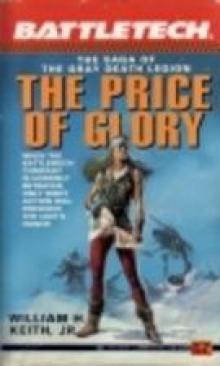 The Price of Glory
The Price of Glory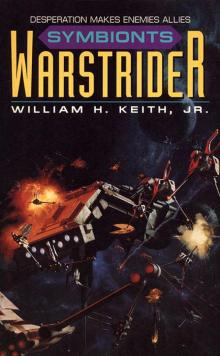 Symbionts
Symbionts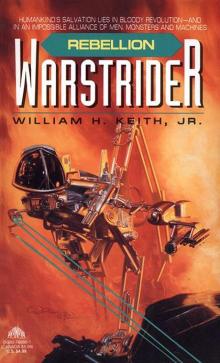 Rebellion
Rebellion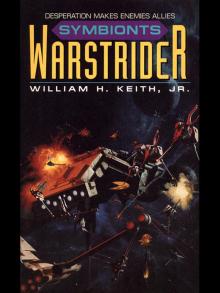 Warstrider 04 - Symbionts
Warstrider 04 - Symbionts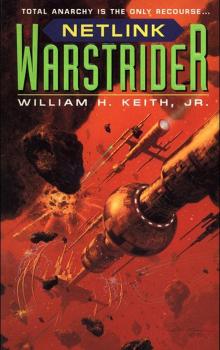 Netlink
Netlink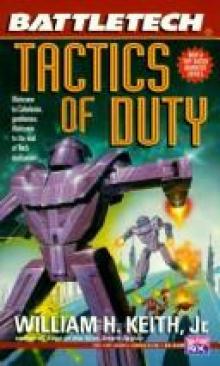 Tactics of Duty
Tactics of Duty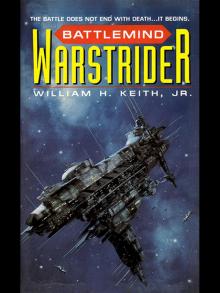 Warstrider 06 - Battlemind
Warstrider 06 - Battlemind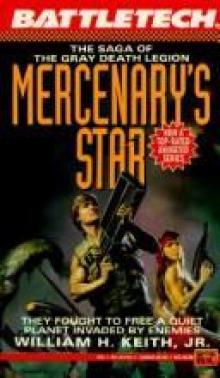 Mercenary's Star
Mercenary's Star Battlemind
Battlemind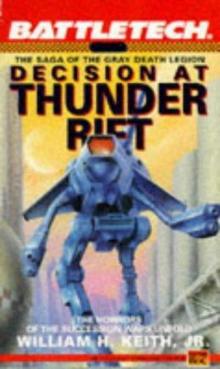 Decision at Thunder Rift
Decision at Thunder Rift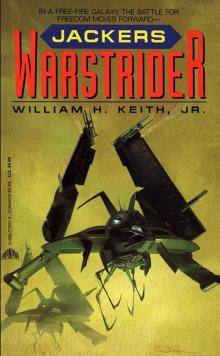 Jackers
Jackers Android: Free Fall
Android: Free Fall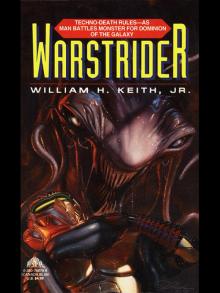 Warstrider 01 - Warstrider
Warstrider 01 - Warstrider Warstrider 05 - Netlink
Warstrider 05 - Netlink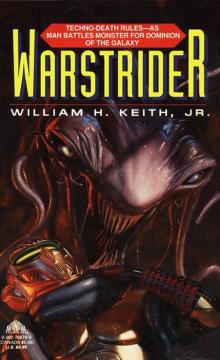 Warstrider
Warstrider